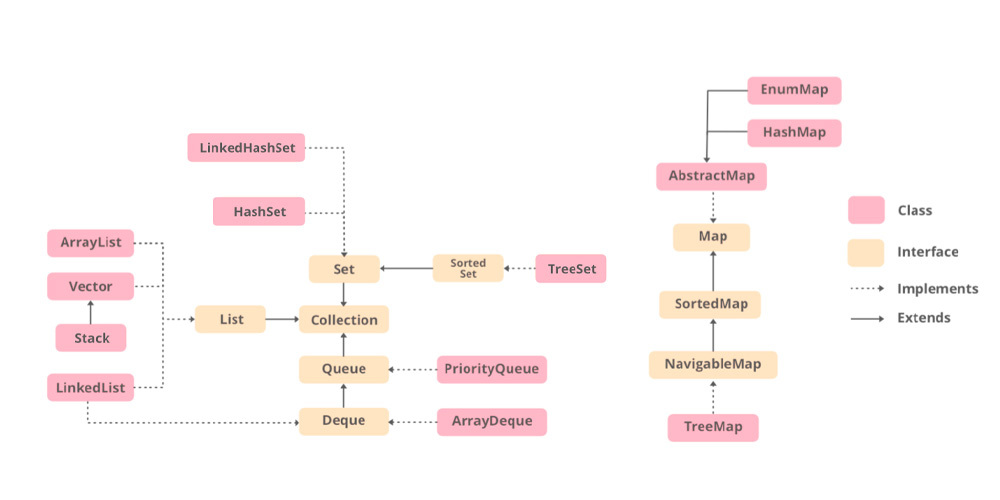Java HashSet vs TreeSet
当涉及到讨论Set之间的差异时,最重要的是插入顺序和如何处理元素的问题。Java中的HashSet是一个实现Set接口的类,由一个哈希表支持,哈希表实际上是一个HashMap实例。这个类允许空元素的存在。该类还为基本操作提供了恒定的时间性能,如添加、删除、包含和大小,假设哈希函数在桶中正确地分散了元素,而TreeSet是SortedSet接口的一个实现,正如其名称所暗示的,它使用树来存储,这里的元素的排序是由一个集合使用其自然排序来维护的,无论是否提供一个显式比较器。

1.速度和内部实现
对于搜索、插入和删除等操作,HashSet平均需要恒定的时间来完成这些操作。HashSet比TreeSet快。HashSet是用一个哈希表实现的。TreeSet在搜索、插入和删除时需要O(Log n),比HashSet高。但是TreeSet保持排序的数据。此外,它还支持像higher()(返回至少高的元素)、floor()、 ceiling()等操作。这些操作在TreeSet中也是O(Log n),在HashSet中不支持。TreeSet是用一个自平衡的二进制搜索树(Red-Black Tree)实现的。TreeSet是由Java中的TreeMap支持的。
2. 排序
HashSet中的元素是没有顺序的。TreeSet维护对象的排序顺序由Java中的Comparable或Comparator方法定义。TreeSet的元素默认以升序排序。它提供了几种方法来处理有序的集合,如first()、last()、headSet()、tailSet()等。
3.空对象
HashSet允许空对象。TreeSet不允许空对象并抛出NullPointerException,为什么,因为TreeSet使用compareTo()方法来比较键,compareTo()会抛出java.lang.NullPointerException。
4. 比较
HashSet使用equals()方法来比较Set中的两个对象,用于检测重复的对象。TreeSet使用compareTo()方法实现同样的目的。如果equals()和compareTo()不一致,即对于两个相等的对象,equals应该返回true,而compareTo()应该返回0,那么它将破坏Set接口的契约,并将允许在Set的实现中出现重复,如TreeSet
注意: 如果你想要一个排序的Set,那么最好是将元素添加到HashSet中,然后将其转换为TreeSet,而不是创建一个TreeSet并添加元素到其中。
看完它们的区别后,你一定想知道 什么时候应该选择TreeSet而不是HashSet ?
- 需要排序的唯一元素而不是唯一元素。TreeSet给出的排序列表总是按升序排列。
- 如果两个条目在顺序上很接近,那么TreeSet就会将它们放在数据结构中的附近,从而放在内存中,而HashSet则将条目分散在内存中,不管它们与哪个键有关。
- TreeSet使用下面的 红黑树算法 来对元素进行排序。当一个人需要经常执行读/写操作时,那么TreeSet是一个不错的选择。
- LinkedHashSet是另一种介于这两者之间的数据结构。它提供了像HashSet一样的时间复杂性,并且保持了插入的顺序(注意,这不是排序的顺序,而是元素插入的顺序)。
实现: 在这里我们将用两个例子来讨论这两个东西。让我们从HashSet开始讨论,然后再讨论TreeSet。
- HashSet的例子
- TreeSet的例子
例1 :
// Java Program to Demonstrate Working of HashSet Class
// Importing required HashSet class from java.util package
import java.util.HashSet;
// Main class
class GFG {
// Main driver method
public static void main(String[] args)
{
// Creating a HashSet object of string type
HashSet<String> hset = new HashSet<String>();
// Adding elements to HashSet
// using add() method
hset.add("geeks");
hset.add("for");
hset.add("practice");
hset.add("contribute");
// Duplicate removed
hset.add("geeks");
// Printing HashSet elements using for each loop
// Display message only
System.out.println("HashSet contains: ");
// Iterating over hashSet using for-each loop
for (String temp : hset) {
// Printing all elements inside above hashSet
System.out.println(temp);
}
}
}
输出
HashSet contains:
practice
geeks
for
contribute
例2 :
// Java Program to Illustrate Working of HashSet Class
// From another Collection
// Importing utility classes
import java.util.*;
class GFG {
// Main driver method
public static void main(String[] args)
{
ArrayList<String> ll = new ArrayList<String>();
// Adding elements to ArrayList
ll.add("Computer");
ll.add("Science");
// Creating HashSet object of string type
HashSet<String> hs = new HashSet(ll);
hs.add("Portal");
hs.add("GFG");
// Iterating via iterators
Iterator<String> iter = hs.iterator();
// Condition holds true till there is single element
// in the List
while (iter.hasNext()) {
// Printing all elements inside objects
System.out.println(iter.next());
}
}
}
输出

现在是 实现TreeSet 的时候了,通过实现它可以更好地理解。
例1 :
// Java program to demonstrate working of
// TreeSet Class
// Importing required classes
import java.util.TreeSet;
// Class
class TreeSetDemo {
// Main driver method
public static void main(String[] args)
{
// Create an empty TreeSet
TreeSet<String> tset = new TreeSet<String>();
// Adding elements to HashSet
// using add() method
tset.add("geeks");
tset.add("for");
tset.add("practice");
tset.add("contribute");
// Duplicate elements being removed
tset.add("geeks");
// Displaying TreeSet elements
System.out.println("TreeSet contains: ");
for (String temp : tset) {
System.out.println(temp);
}
}
}
输出
TreeSet contains:
contribute
for
geeks
practice
例2 :
// Java Program to Illustrate Working of TreeSet
// From another Collection
// Importing utility classes
import java.util.*;
// Main class
class GFG {
// Main driver method
public static void main(String[] args)
{
// Creating list of string
ArrayList<String> ll = new ArrayList<String>();
// Adding elements to ArrayList
// using add() method
ll.add("Computer");
ll.add("Science");
// Creating TreeSet object of string type
TreeSet<String> ts = new TreeSet(ll);
// Adding elements to above TreeSet
ts.add("Portal");
ts.add("GFG");
// Iterating via iterators
Iterator<String> iter = ts.iterator();
// Condition that holds true till
// there is single element in th List
while (iter.hasNext()) {
// Printing all elements inside objects
System.out.println(iter.next());
}
}
}
输出

 极客教程
极客教程